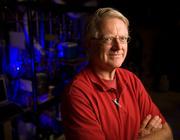
Research
Janda Lab Projects and Research
In the Janda Lab, we study the kinetics of gas hydrates, which is very important to understand the technical challenges to turn this abundant source into a producible and usable source of energy.
In the United States, the search for a new usable source of energy is important to sustain human life. As the population continues to increase exponentially, natural gas supplies are in tight supply and costs are escalating. In 1995, the U.S. Geological Survey (USGS) made the assessment that the amount of hydrate gas in the environment greatly exceeds that of natural domestic gas resource. However, while the abundance of the gas hydrates is high, the process to scientifically and technologically turn this source to a usable form of energy is still unknown. (http://www.geotimes.org/nov04/feature_futurehydrates.html)
In order to better understand the chemistry of gas hydrates, the Janda Lab at UC Irvine is looking at proper ways to safely store and transport gas hydrates by examining the right temperature and pressure for certain types of gas hydrate. Moreover, we further investigate the kinetics of other helper gases such as xenon and difluoromethane and how they facilitate the gas uptaking process.
Additionally, Janda Lab provides valuable research into halogen hydrates. Halogen molecules are stable diatomic molecules which have rich valence electronic spectra that extend into the visible region. They are often used for studying a wide range of chemical systems including intermolecular forces in clusters and the solid solution theory of cluster hydrates. The first Chlorine hydrate clathrate was discovered by Sir Humphry Davy in the year of 1810. Starting from this, scientists have been focusing on the structures and thermodynamics of gas hydrate clathrate. Meanwhile, bromine hydrate, one of the first clathrate hydrates discovered, has played a significant role in the development of models for all clathrate hydrates. The first attempt to study the bromine hydrate by X-ray powder diffraction by Von Stackelberg and Muller gave results that were interpreted in terms of the cubic structure I hydrate or CS-I. This result; however, in light of more recent information, including the work of Dr. Janda and more workers at UC Irvine, is not the thermodynamic stable structure. Our work in Janda lab are based on the study of the TS-I structure bromine hydrate clathrate, which can help us to obtain a further understanding of other halogen gas clathrate and even double gas clathrate.
The undergraduate team of Janda Lab is focusing the majority of their energy on finding the optimal conditions for which gas clathrates form. This work is a continuation of the research conducted by Joel Rivera, a Janda Lab alumnist who is quoted (in part) below.
Janda Lab research includes the kinetics of the formation of gas clathrate hydrates – compounds made when water molecules bond to form cages around gaseous molecules. The work has huge potential. There are a trillion tons of methane stored in deposits under the world’s oceans, “enough to run the country for 500 years” [explains Dr.Janda.] (Propane is almost identical to methane and easier to work with in a lab.)
Methane, however, is a potent, combustible greenhouse gas. Watching reports on the Gulf of Mexico oil spill last summer, Joel Rivera, [a former Janda Lab graduate] says, he was stunned to realize that a methane blowout could have caused the deadly explosion and prevented the leak from being quickly capped.
If the substance could be extracted safely and frozen in huge blocks, it could be transported more easily than highly explosive liquefied gas. Employing available data that shows fuels like methane and propane – essentially oils – could, in fact, be frozen in water, one of the projects being explored in the Janda lab is to figure out precisely the right size of ice for maximum storage of volatile gases.
“The key is you want to expose as much of the ice to the propane as possible, and to do that, you want to use the smallest ice grains possible,” [Joel Rivera, Janda Lab researcher, 2011]
(exerpt taken from 2011 article, Janet Wilson, University Communications. Click here for original article)


